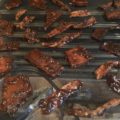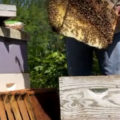I have to give credit to Tim Artz at Tim’s Food Obsession for my discovery of Nocino. I discovered his blog, and Nocino about three years ago and per his instruction, have been making it each June ever since. It’s too easy and rewarding not to, and it harkens to my inner soul about capitalizing on what’s currently in season.
Tim instructs us on the 24th of June, collect 24 walnuts. Well, it was a little earlier than that for me this year, and I’m usually collecting many more so that I can also make the walnut preserves that I also like to make. I’ve found the preserves want the walnuts even younger. In both cases, it entails collecting young, green walnuts that have to be knocked off the tree. The idea is to collect them well before the shell begins to harden or nut begins to form. In my case, I’m collecting black walnuts here in SE Indiana.
Nocino is a thicker, dark brown liqueur originating in the Emilia-Romagna region of Northern Italy. We try to collect the walnuts avoiding oxidation by not scaring them or leaving them to sit too long before placed in an alcoholic base. In this case, we use Everclear and steep the quartered walnuts for about 40 days along with other spices and flavorings.
Once steeping is done, it’s mixed with a simple syrup to sweeten. Nocino has an aromatic and bittersweet, flavor. Individual Italian families often have their own recipes that include variations like the addition of cinnamon, juniper berries, lemon or orange zest, vanilla pods, coffee beans, and clove. I can always dig into anything that encourages the imagination to run wild. So in my latest batch, here’s what I did.

Collect, clean and quarter the walnuts. I have recently read that boiling the walnuts ahead of time helps with the steeping stage. I plan to try this sometime. If there is one thing I’d like to have more control over, it’s the bitterness in Nocino. Last year, I ran it through a fine wine filter to get out the fine tannic-heavy particles that seem to settle on the bottom to see if it helps.
Load the ingredients into a jar and top up with 100% Everclear for the steeping stage. Keep track of how many liters of alcohol is used as this will be needed to calculate the sweetening stage later.

Once done steeping, about 40 days… strain out everything leaving just the liqueur and filter through whatever you have… I’ve tried coffee filters, layers of cheesecloth, and again, even a dedicated wine filter. The idea is to get out the black sediment that you will see that contributes to the bitterness. It does stop up the filters and takes a while for it to get through.

Measure your liquid volume and you will be cutting this to the proof you desire. Remember, this is still as hot as Everclear. Tim suggested 80 proof. I’m between there and 70 proof. For each liter of alcohol you used, add 800 grams of sugar. I used honey last year and did like it but I admit, I went by taste… since I had already cut the alcohol to a palatable proof. Heat just until your sweetener is dissolved. It takes no heat at all with honey since it’s water-soluble.
From here, I did add mine back to the bulk glass vessel and let it settle out for several more months racking it off the bitter sediment that settled to the bottom from time to time. I’m just now getting to bottle last years Nocino. I do believe a bit of bottle age is important just like in wine… so, we’ll give it another month or so before trying it out. After all, I have this years batch to keep me busy for a while.
I’d love to hear tips or ideas from others who make Nocino!

Collect green walnuts and wash them! 
Collect green walnuts and wash them! 
Walnuts for Nocino only need to be quartered, but I’m also peeling them for the preserved walnuts. 
Peeling for preserved walnuts is not necessary for Nocino. 
Quartered walnuts nixed with cinnamon sticks, cloves, star anise, vanilla bean and chipped orange peel. 
Quartered walnuts nixed with cinnamon sticks, cloves, star anise, vanilla bean and chipped orange peel. 
Set outside for around 40 days. It will start to turn black.





[…] is the “other” black walnut project I have been working on in addition to the nocino. I am working on preserved walnuts. Not pickled, mind you. This is important to understand because […]